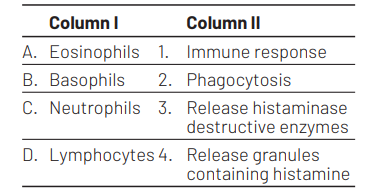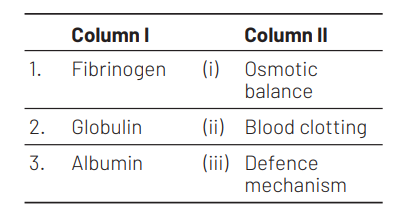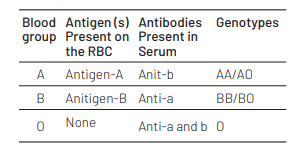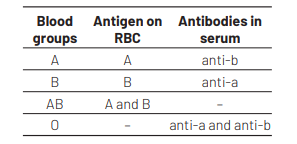Question
Persons with ‘AB’ blood group are called as “universal recipients”. This is due to [NEET 2021]
(a) absence of antigens-A and B on the surface of RBCs
(b) absence of antigens-A and $B$ in plasma
(c) presence of antibodies, anti-A and anti-B on RBCs
(d) absence of antibodies, anti-A and anti-B in plasma
Answer/Explanation
Ans. (d)
Person with $A B$ blood group are universal recipient because they do not have any antibodies to anti-A and anti- $\mathrm{B}$ in their blood hence they can receive blood from a donor of any blood type. During transfusion, plasma is matched to avoid $A$ and $B$ antibodies in the transfused plasma that will attack the recipient’s red blood cells. Person with AB blood type does not contain A and B antibodies in plasma. Therefore, they are also called universal plasma donors.
Question
Which enzyme is responsible for the conversion of inactive fibrinogens to fibrins? [NEET 2021]
(a) Thrombin
(b) Renin
(c) Epinephrine
(d) Thrombokinase
Answer/Explanation
Ans. (a)
Plasma contains prothrombin and fibrinogen. During clotting, inactive prothrombin converts to active thrombin. Thrombin acts as a proteolytic enzyme to convert soluble plasma protein fibrinogen molecule produced from the liver in the presence of vitamin- $\mathrm{K}$ to form insoluble fibrin monomer.
Question
Match the following columns and select the correct option. [NEET (Sep.) 2020]

A B C D
(a) 4 1 2 3
(b) 1 2 4 3
(c) 2 1 3 4
(d) 3 4 2 1
Answer/Explanation
Ans. (d)
Option (d) is the correct. It can be explained as follows
Eosinophils are associated with allergic reactions and release histaminase, destructive enzymes. Basophils secrete histamine, serotonin, heparin, etc. and are involved in inflammatory reactions.
Neutrophils are phagocytic cells. Both B and Tlymphocytes are responsible for immune responses of the body.
Question
Which of the following gastric cells indirectly help in erythropoiesis? [NEET 2018]
(a) Goblet cells
(b) Mucous cells
(c) Chief cells
(d) Parietal cells
Answer/Explanation
Ans. (d)
Parietal cells (oxyntic cells) secrete hydrochloric acid and castle intrinsic factor. $\mathrm{HCl}$ converts iron (in diet) from ferric to ferrous form which can be easily absorbed and used during erythropoiesis (formation of RBCs).
Castle intrinsic factor helps in absorbing vitamin- $B_{12}$ and its deficiency causes pernicious anaemia. The functions of other cells are as follows
Mucous or Goblet cells secrete mucus that lines the stomach and protects it from the acid present in stomach. Chief cells secrete gastric digestive enzymes as proenzymes or zymogens.
Question
Match the items given in Column I with those in Column II and select the correct option given below [NEET 2018]

1 2 3
(a) (i) (iii) (ii)
(b) (i) (ii) (iii)
(c) (iii) (ii) (i)
(d) (ii) (iii) (i)
Answer/Explanation
Ans. (d)
Fibrinogen is a soluble plasma protein that is stimulated by thrombin and gets converted into insoluble form fibrin. The latter helps in the formation of blood clot to seal the wound and stop bleeding. Globulins are simple proteins that form a large fraction of blood serum proteins involved in defence mechanism. There are four main types of globulins that are manufactured in liver, namely alpha-1, alpha-2, beta and gamma.
Albumin is a plasma protein that is manufactured by the liver. It helps in maintaining osmotic pressure which prevents the fluid-leakage out into the tissues from the bloodstream.
Question
Adult human RBCs are enucleate. Which of the following statement(s) is/are most appropriate explanation for this feature? [NEET 2017]
(I) They do not need to reproduce.
(II) They are somatic cells.
(III) They do not metabolise.
(IV) All their internal space is available for oxygen transport. Codes
(a) Only (IV)
(b) Only (I)
(c)(I), (III) and (IV)
(d)(II) and (III)
Answer/Explanation
Ans. (a)
The absence of nucleus in RBC is an adaptation that allows it to contain more haemoglobin and carry more oxygen by providing empty space. This adaptation also aids in effective diffusion of oxygen. Concept Enhancer RBCs are initially produced in bone marrow with a nucleus. They, then undergo enucleation at maturity, in which their nucleus is removed.
Question
Name the blood cells, whose reduction in number can cause clotting disorder, leading to excessive loss of blood from the body. [NEET 2016, Phase II]
(a) Erythrocytes
(b) Leucocytes
(c) Neutrophils
(d) Thrombocytes
Answer/Explanation
Ans. (d)
A reduction in number of thrombocytes can lead to clotting disorders which will result in excessive loss of blood from the body. These are also called blood platelets.
Question
Serum differs from blood in [NEET 2016, Phase II]
(a) lacking globu lins
(b) lacking albu mins
(c) lacking clotting factors
(d) lacking antibodies
Answer/Explanation
Ans. (c)
When all clotting factors along with cells are removed from plasma, it becomes serum.
Question
Person with blood group $A B$ is considered as universal recipient because he has [CBSE AIPMT 2014]
(a) Both $A$ and $B$ antigens on RBC but no antibodies in the plasma
(b) Both A and B antibodies in the plasma
(c) No antigen on RBC and no antibody in the plasma
(d) Both A and B antigens in the plasma but no antibodies
Answer/Explanation
Ans. (a)
Blood group $A B$ is universal recipient because the person with $A B$ blood group has both $A$ and $B$ antigens on RBC but no antibodies in the plasma.Other blood group and their genotypes are given below
Question
$\overline{10}$ A certain road accident patient with unknown blood group needs immediate blood transfusion. His one doctor friend at once offers his blood. What was the blood group of the donor? [CBSE AIPMT 2012]
(a) Blood group B
(b) Blood group $A B$
(c) Blood group
(d) Blood group
Answer/Explanation
Ans. (c)
Blood group is tested by two types of sera, i.e. anti-A (antibody-A) and anti-B (antibody-B). Persons with blood group 0 possess both antibodies in their plasma but have no antigens in their RBCs. So, RBCs of blood group ‘ $O$ ‘ do not show clumping in any of the two sera. Thats why, persons with blood group ‘ $O$ ‘ are called universal donor and they can donate blood to a person with any type of blood group.
Question
Which one the following plasma proteins is involved in the coagulation of blood? [CBSE AIPMT 2011]
(a) Serum amylase
(b) A globulin
(c) Fibrinogen
(d) An albumin
Answer/Explanation
Ans. (c)
Fibrinogen (factor 1] is a soluble plasma glycoprotein, synthesised by the liver. It is converted by thrombin into fibrin during blood coagulation. Fibrin is then cross-linked by factor XIII to form a clot.
Question
A person with unknown blood group under $\mathrm{ABO}$ system, has suffered much blood loss in an accident and needs immediate blood transfusion. His one friend who has a valid certificate of his own blood type, offers for blood donation without delay. What would have been the type of blood group of the donor friend? [CBSE AIPMT 2011]
(a) Type AB
(b) Type 0
(c) Type A
(d) Type B
Answer/Explanation
Ans. (b)
Blood type ‘O’ has no antigen but both types of antibodies ‘ $a$ ‘ and ‘ $\mathrm{b}$ ‘. The person with blood type ‘ $O$ ‘ is universal donor.
Question
The most popularly known blood grouping is the $A B O$ grouping. It is named $A B O$ and not $A B C$ because ‘ $O$ ‘ in it refers to having [CBSE AIPMT 2009]
(a) other antigens besides $A$ and $B$ on RBCs
(b) over dominance of this type on the genes for $A$ and $B$ types
(c) one antibody only-either anti-A or anti-B on the RBCs
(d) no antigens $A$ and $B$ on RBCs
Answer/Explanation
Ans. (d)
Landsteiner divided human population into four groups based on the presence of antigens found in their RBCs. Each group represented a blood group. Thus, there are four types of blood groups $A, B$, $A B$ and $O$. Blood group ‘ $O$ ‘ does not contain any antigen on RBCs, hence can be given to any person, that’s why this blood group is called universal donor.
Question
If you suspect major deficiency of antibodies in a person, to which of the following would you look for confirmatory evidence? [CBSE AIPMT 2007]
(a) Serum albumins
(b) Serum globulins
(c) Fibrinogen in the plasma
(d) Haemocytes
Answer/Explanation
Ans. (b)
Deficiency of antibodies can be confirmed by serum globulins as antibodies are also called immunoglobulins and constitute the gamma globulin part of blood proteins. These are secreted by activated B-cells or plasma cells.
Question
A drop of each of the following, is placed separately on four slides. Which of them will not coagulate?
(a) Blood plasma
(b) Blood serum
(c) Sample from the thoracic duct of lymphatic system
(d) Whole blood from pulmonary vein
Answer/Explanation
Ans. (b)
Serum will not coagulate. Because serum do not contain clotting factor, RBCs or WBCs. It is blood plasma not. including the fibrinogens.
Question
Examination of blood of a person suspected of having anaemia, shows large, immature, nucleated erythrocytes without haemoglobin. Supplementing his diet with which of the following, is likely to alleviate his symptoms? [CBSE AIPMT 2006]
(a) Thiamine
(b) Folic acid and cobalamin
(c) Riboflavin
(d) Iron compounds
Answer/Explanation
Ans. (d)
Anaemia refers to any condition in which there is an abnormally low haemoglobin concentration and/or blood cell count. The most common cause is deficiency of iron which is an essential element of haemoglobin molecule. Thus, the iron compounds in the diet will help to alleviate the symptoms of anaemia.
Question
Antibodies in our body are complex [CBSE AIPMT 2006]
(a) lipoproteins
(b) steroids
(c) prostaglandins
(d) glycoproteins
Answer/Explanation
Ans. (d)
Antibodies are the proteins (glycoproteins) called immunoglobulins. These are produced by B-lymphocytes in response to entry of a foreign substance or antigen into the body. Lipoproteins are the micellar complex of protein and lipids.Steroids are a group of lipids derived from a saturated compound cyclopentano perhydrophenanthrene which has a nucleus of four rings.
Prostaglandin is a group of organic compounds derived from essential fatty acids and causing a range of physiological effects in animals.
Question
Which of the following substances, if introduced in the blood stream, would cause coagulation, at the site of its introduction? [CBSE AIPMT 2005]
(a) Fibrinogen
(b) Prothrombin
(c) Heparin
(d) Thromboplastin
Answer/Explanation
Ans. (d)
Lipoproteinaceous, thromboplastin is released by the injured tissue which causes blood clotting. In blood vessels, thromboplastin do not release due to which blood does not clot.
But external thromboplastin to blood will cause blood clotting at the site of its introduction due to the formation of prothrombinase.
Question
You are required to draw blood from a patient and to keep it in a test tube for analysis of blood corpuscles and plasma. You are also provided with the following four types of test tubes. Which of them will you not use for the purpose? [CBSE AIPMT 2004]
(a) Test-tube containing calcium bicarbonate
(b) Chilled test tube
(c) Test tube containing heparin
(d) Test tube containing sodium oxalate
Answer/Explanation
Ans. (a)
Clotting of collected blood can be prevented by coating the test tubes with silicon or adding chelating agents. Citrate, oxalate, heparin and EDTA are anticoagulants.
Question
What is correct regarding leucocytes? [CBSE AIPMT 2000]
(a) These can squeeze out through (can cross) the capillary walls
(b) These are enucleate
(c)Sudden fall in their number indicates cancer
(d) These are produced in thymus
Answer/Explanation
Ans. (a)
Most of the T and B-lymphocytes (types of leukocytes) continuously circulate between the blood and lymph. These leave the blood stream, squeezing out between specialised endothelial cuts found in certain small vessels and enter various tissues including all the lymph nodes.
After percolating through a tissue, these accumulate in small lymphatic vessels which connect to a series of lymph nodes, from where they ultimately enter the main lymphatic vessel (thoracic duct) which carries them back into the blood.
Question
What is correct for blood group ‘0? [CBSE AIPMT 2001, 1999]
(a) No antigens but both $a$ and $b$ antibodies are present
(b) A antigen and $\mathrm{b}$ antibody
(c)Antigen and antibody both absent
(d) A, B antigens and $a$, $b$ antibodies
Answer/Explanation
Ans. (a)
In blood of ‘ $O$ ‘ group, no antigens are present on red blood cells, but both anti-a and anti- $b$ antibodies are present in plasma. Blood group A has antigen ‘A’ and antibody ‘ $\mathrm{b}$ ‘. Blood group $B$ has antigen ‘ $B$ ‘ and antibody’a’. Blood group $A B$ has antigens ‘A’ and ‘ $B$ ‘ but no antibody in plasma.
Question
Haemoglobin is a type of [CBSE AIPMT 1999]
(a) carbohydrate
(b) vitamin
(c) skin pigment
(d) respiratory pigment.
Answer/Explanation
Ans. (d)
Haemoglobin $(\mathrm{Hb})$ is a proteinaceous respiratory pigment made up of a protein called globin with iron $\left[\mathrm{Fe}^{2+}\right]$ containing porphyrin as prosthetic group. It binds to oxygen reversibly.
Question
Which is the principal cation in the plasma of the blood? [CBSE AIPMT 1999]
(a) Magnesium
(b) Sodium
(c) Potassium
(d) Calcium
Answer/Explanation
Ans. (b)
The concentration of $\mathrm{Na}^{+}$in plasma is $0.32 \%$ followed by $\mathrm{K}^{+}(0.02 \%)$ and magnesium ( $0.0025 \%)$.
The mineral ions like $\mathrm{Na}^{+}$and others present in the blood plasma play an essential role in the maintenance of osmotic pressure of the blood.
Question
Which of the following is agranulocyte? [CBSE AIPMT 1997]
(a) Lymphocyte
(b) Eosinophil
(c) Basophil
(d) Neutrophil
Answer/Explanation
Ans. (a)
White Blood Corpuscles (WBC)or leucocytes can be divided into two groups on the presence/absence of minute granules in the cytoplasm.
(a) Granulocytes which containgranules. e.g. neutrophils, eosinophils and basophils.
(b) Agranulocytes which do not contain granules. lymphocytes, monocytes.
Question
The life span of human WBC is approximately [CBSE AIPMT 1997]
(a) less than 10 days
(b) between 20-30 days
(c) between 2-3 months
(d) more than 4 months
Answer/Explanation
Ans. (a)
Human WBC (or leukocytes) life span is approximately less than 10 days.
Leukocytes constitute less than $1 \%$ of the cells in human blood. They are large in size than red blood cells. They have nucleus but no haemoglobin.
Question
Which one of the following vertebrate organs receives the oxygenated blood only? [CBSE AIPMT 1996]
(a) Gill
(b) Lung
(c) Liver
(d) Spleen
Answer/Explanation
Ans. (d)
Only spleen and brain always receive oxygenated blood. Gills and lungs are the blood purifying organs, i.e. here blood becomes oxygenated and these two organs always receive deoxygenated blood. Liver is a part of hepatic portal system, in which hepatic portal vein carries food laiden blood from alimentary canal and associated glands before finally returning to heart.
Question
Antigens are present [CBSE AIPMT 1995]
(a) inside the nucleus
(b) on cell surface
(c) inside the cytoplasm
(d) on nuclear membrane
Answer/Explanation
Ans. (b)
Antigens (Ag) are foreign particles present on the surface of cell and when intraduced in the blood they initiate a specific immune response against themselves.
Question
Cells formed in bone marrow include [CBSE AIPMT 1993]
(a) RBC
(b) RBC and leucocytes
(c) leucocytes
(d) lymphocytes
Answer/Explanation
Ans. (b)
In the developing foetus, the haemopoietic tissues are liver and spleen, while after birth RBCs are mainly produced in the bone marrow of the long bones. The formation of leucocytes occurs in the bone marrow, Peyer’s patches, lymph nodes, thymus, spleen etc. and it is called as leucopoiesis.
Question
Removal of calcium from freshly collected blood would [CBSE AIPMT 1989]
(a) cause delayed clotting
(b) prevent clotting
(c)cause immediate clotting
(d) prevent destruction of haemoglobin
Answer/Explanation
Ans. (b)
Blood clotting starts when prothrombinase in the presence of $\mathrm{Ca}^{2+}$ converts inactive prothrombin into thrombin which in turn converts dissolved fibrinogen protein into fine thread-like fibrin. The network of fibrin covers the wound in which blood corpuscles get endulge and form clot. If $\mathrm{Ca}^{2+}$ is removed, it will prevent clotting.
Question
In the ABO system of blood groups, if both antigens are present but no antibody, the blood group of the individual would be [CBSE AIPMT 2004, 1991]
(a) $B$
(b) 0
(c) $A B$
(d) $\mathrm{A}$
Answer/Explanation
Ans. (c)
Hence, blood group AB has no antibodies in serum but both antigens $A$ and $B$.
Question
A person with blood group A requires blood. The blood group which can be given is [CBSE AIPMT 1989]
(a) $A$ and $B$
(b) $A$ and $A B$
(c) A and 0
(d) $A, B, A B$ and $O$
Answer/Explanation
Ans. (c)
Blood group A has A antigen and $b$ antibody and blood group 0 has no antigens and both $a$ and $b$ antibodies so, if a patient with blood group A needs blood, both $A$ and $O$ blood group can be given to him.
Question
Which one engulfs pathogens rapidly? [CBSE AIPMT 1989]
(a) Acidophils
(b) Monocytes
(c) Basophils
(d) Neutrophils
Answer/Explanation
Ans. (d)
Neutrophils are granulocytes, i.e., cytoplasm is filled with fine granules. These granules are actually lysosome and Golgi bodies. These are the chief phagocytic cells of the body and engulf the microbes by phagocytosis, so neutrophils are also called soldiers of the body.
Question
Child death may occur in the marriage of [CBSE AIPMT 1988, 2000]
(a) $\mathrm{Rh}^{+}$man and $\mathrm{Rh}^{+}$woman
(b) $\mathrm{Rh}^{+}$man and $\mathrm{Rh}^{-}$woman
(c) $\mathrm{Rh}^{-}$man and $\mathrm{Rh}^{-}$woman
(d) $\mathrm{Rh}^{-}$man and $\mathrm{Rh}^{+}$woman
Answer/Explanation
Ans. (b)
Rhesus antibodies are formed in the plasma of $\mathrm{Rh}^{-}$woman who have been pregnanted with $\mathrm{Rh}^{+}$babies, if the foetal blood leaks across the placenta during the birth the mother body starts preparing antibodies against the $\mathrm{Rh}$-antigen. Later $\mathrm{Rh}^{+}$foetus would be at risk and may suffer from haemolysis.
Question
R B C s$ do not occur in [CBSE AIPMT 1988]
(a) frog
(b) cow
(c) camel
(d) cockroach
Answer/Explanation
Ans. (d)
RBCs or red blood corpuscles are meant for the transportation of respiratory gases in the blood and these are present in all vertebrates. In cockroach haemolymph is present which serves for the transportation of nutrients, maintains hydrostatic pressure and acts as a reservoir of water.
Question
Breakdown product of haemoglobin is [CBSE AIPMT 1988]
(a) bilirubin
(b) iron
(c) biliverdin
(d) calcium
Answer/Explanation
Ans. (a)
Haemoglobin of erythrocytes split off into heme and globin. The core of iron in heme is salvaged, bound to protein as hemosiderin and stored for reuse. The remaining of the heme group is degraded to bilirubin a yellow pigment. that is released into the blood. Bilirubin is picked up by liver cells which in turn secrete it into the intestine where it is metabolised to urobilinogen.
Question
One of the factors required for the maturation of erythrocytes is [CBSE AIPMT 1998]
(a) vitamin-D
(b) vitamin-A
(c) vitamin- $B_{12}$
(d) vitamin-C
Answer/Explanation
Ans. (c)
Vitamin-B 12 (cobalamin) promotes DNA synthesis, maturation of erythrocytes and myelin formation. Vitamin-D (calciferol), It is necessary for the formation of healthy bones and teeth. Vitamin-A (retinol), It is necessary for proper body growth and night vision. Vitamin-C (ascorbic acid), It helps in wound healing, blood formation and absorption of iron.
Question
The haemorrhagic disease of new born is caused due to the deficiency of [CBSE AIPMT 1995]
(a) vitamin-A
(b) vitamin $-B_1$
(c) vitamin- $\mathrm{B}_{12}$
(d) vitamin-K
Answer/Explanation
Ans. (d)
The haemorrhagic disease of new born is caused due to the deficiency of vitamin- $\mathrm{K}$, characterised by delayed blood clotting and haemorrhage (blood loss).
Question
Vitamin- $K$ is required for [CBSE AIPMT 1993]
(a) formation of thromboplastin
(b) conversion of fibrinogen to fibrin
(c) conversion of prothrombin to thrombin
(d) synthesis of prothrombin
Answer/Explanation
Ans. (d)
Vitamin-K (phylloquinone) is required for the synthesis of prothrombin necessary for blood clotting. It is synthesised by bacteria in the colon. Vitamin-K is commonly called anti-haemorrhagic
vitamin. Its deficiency leads to bleeding, i.e. no coagulation or clotting.
